Cryptid Files
Bigfoot vs Yeti: If They Fought in 3 Different Arenas, Who Would Actually Win?
Bigfoot vs Yeti: If They Fought in 3 Different Arenas, Who Would Actually Win? This is the question that echoes from the frozen peaks of the Himalayas to the deepest forests of North America, a query whispered in hushed tones around campfires and debated furiously across the internet. At IHeartCryptids.com, we believe a question this epic deserves more than a simple guess; it demands a full-scale, tactical breakdown.
Forget what you think you know. We are about to step into the ring with these two titans, analyzing their strengths, their weapons, and their minds. We will simulate their legendary battle not once, but three times, in three distinct and brutal arenas, to finally declare the undisputed champion of the cryptid world. This is the ultimate fight night.
More than just a story, the Bigfoot has become a part of our modern folklore. For those looking to bring a piece of this legend into the real world, we’ve curated a special collection. Check out our guide to the most unique Bigfoot gifts to find a truly meaningful item.
Bigfoot vs Yeti: The Definitive Battle Simulation
Welcome, ladies and gentlemen, to the most anticipated matchup in the history of the unknown. In one corner, weighing in with an aura of ancient mystery and ice-cold resilience, the Ghost of the Himalayas, the Yeti! And in the other corner, a titan of the timberlands, boasting unparalleled power and legendary stealth, the Guardian of the North American Woods, Bigfoot!
For too long, this clash has been a matter of pure speculation. No more. Tonight, we move beyond folklore and into forensic analysis. We will dissect these legendary combatants piece by piece—their physical armaments, their psychological warfare, their environmental mastery. We will then place them in three unique, unforgiving arenas to simulate, blow-by-blow, how their battle would unfold. By the end of this analysis, we will have a definitive answer, grounded in evidence and expert theory, to the ultimate question: Who would win?
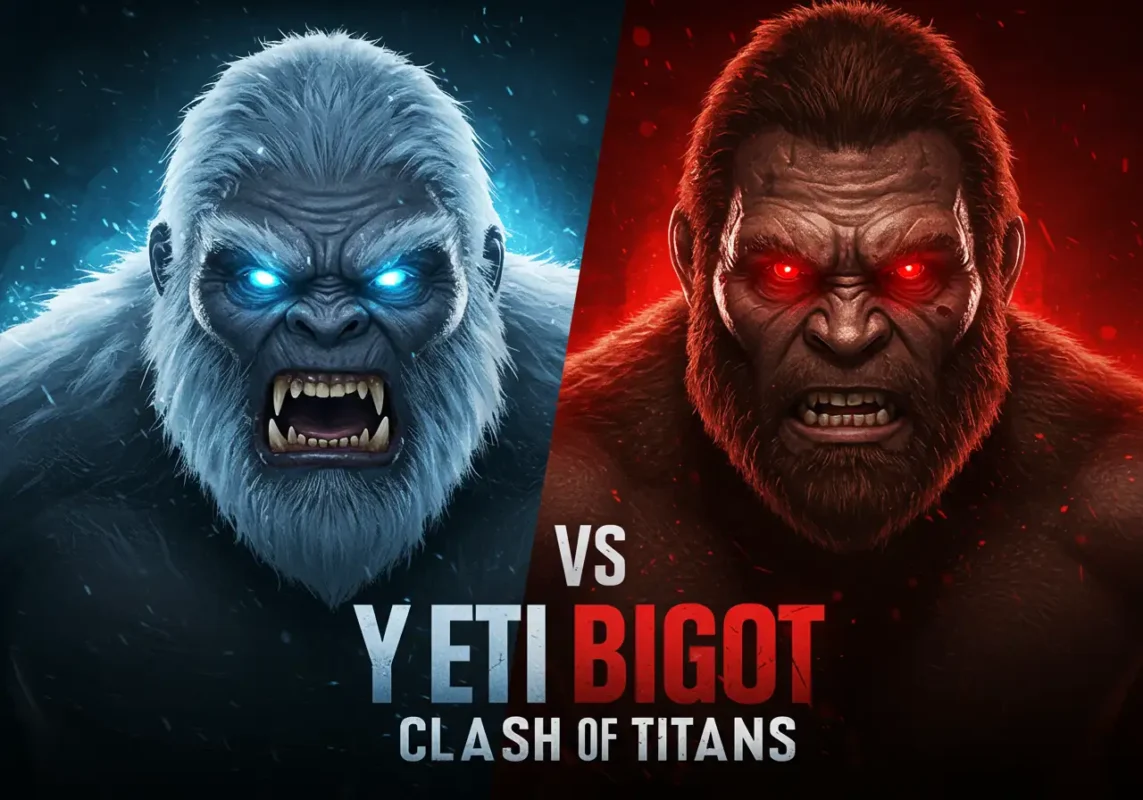
Yeti vs Bigfoot fight
1. The Ultimate Tale of the Tape: A Pre-Fight Tactical Breakdown
Every great fight begins with the stats. This is our in-depth, pre-fight analysis, comparing every conceivable metric to understand the advantages each titan brings to the ring. This goes beyond simple height and weight; we’re looking at their entire profile as a fighter.
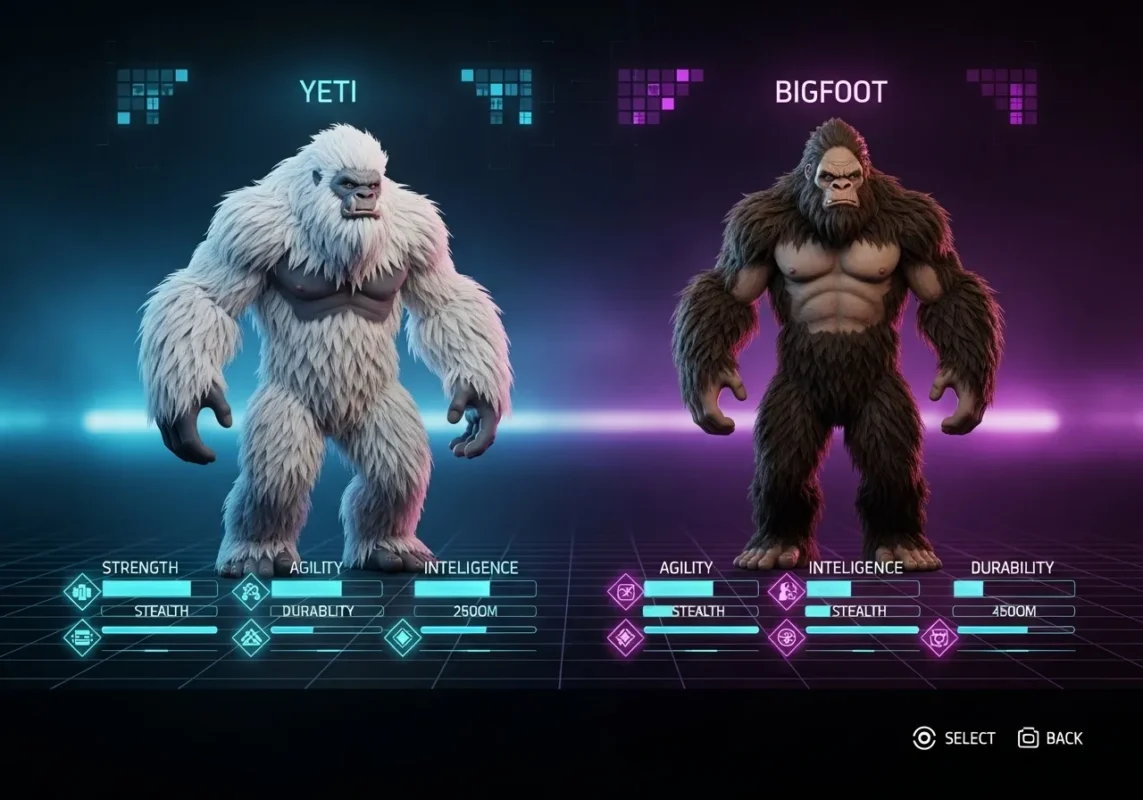
Yeti vs Bigfoot character stats screen
| Combat Metric | Yeti (The Alpine Assassin) | Bigfoot (The Forest Brawler) | Ringside Analysis |
| Height | 6 – 10 ft (1.8 – 3 m) | 7 – 10 ft (2.1 – 3 m) | Bigfoot has a slight edge in average height, providing better reach. |
| Weight | 200 – 400 lbs (90 – 181 kg) | 500 – 900 lbs (227 – 408 kg) | MASSIVE Bigfoot Advantage. This is the biggest physical differentiator. Bigfoot brings overwhelming mass and power. |
| Reach | 7 – 9 ft arm span (est.) | 8 – 11 ft arm span (est.) | Proportional to height, Bigfoot’s longer arms are a significant advantage in a striking battle. |
| Primary Weapon | Claws (for gripping rock/ice), powerful bite, environmental objects (rocks). | Raw kinetic force (fists, shoulders), immense grappling/crushing strength, thrown objects (rocks, logs). | Yeti is a tactical fighter; Bigfoot is a power brawler. |
| Armor/Durability | Thick fur for insulation, dense muscle, extreme cold/altitude resistance. | Thick hide, massive bone structure, dense musculature designed for power. | Yeti’s durability is against the elements. Bigfoot’s durability is for physical combat. |
| Fighting Stance | Lower center of gravity, agile, likely moves in and out of range. | Upright, powerful, gorilla-like stance. A stable, rooted fighter. | A classic “Dancer vs. Brawler” matchup. |
| Intelligence | Considered highly cunning, strategic, capable of complex thought. | High environmental intelligence, master of stealth, uses tools (wood-knocking). | Yeti likely holds the edge in pure tactical intelligence and problem-solving. |
| Psychological Warfare | Eerie, high-pitched screams to disorient; legendary elusiveness creates fear. | Intimidating roars, bluff charges, alleged use of infrasound to induce dread. | Both are masters of intimidation, but Bigfoot’s infrasound ability, if real, is a game-changer. |
| Signature Move | The “Mountain Ghost” (using terrain for a fatal ambush). | The “Sasquatch Slam” (a full-body, high-impact charge). | Yeti relies on strategy, Bigfoot on overwhelming force. |
| Key Weakness | Significantly lower body mass; less raw power. | Less agile; potentially vulnerable in complex, vertical terrain. | Each creature’s greatest strength highlights the other’s weakness. |
Pre-Fight Conclusion: This is a classic battle of Brains vs. Brawn, Agility vs. Power. Bigfoot is the overwhelming favorite in a straight-up brawl on flat ground. However, the Yeti is a cunning survivor forged in a brutal environment. Its only path to victory is to avoid Bigfoot’s power and use its intelligence and agility to turn the environment itself into a weapon.
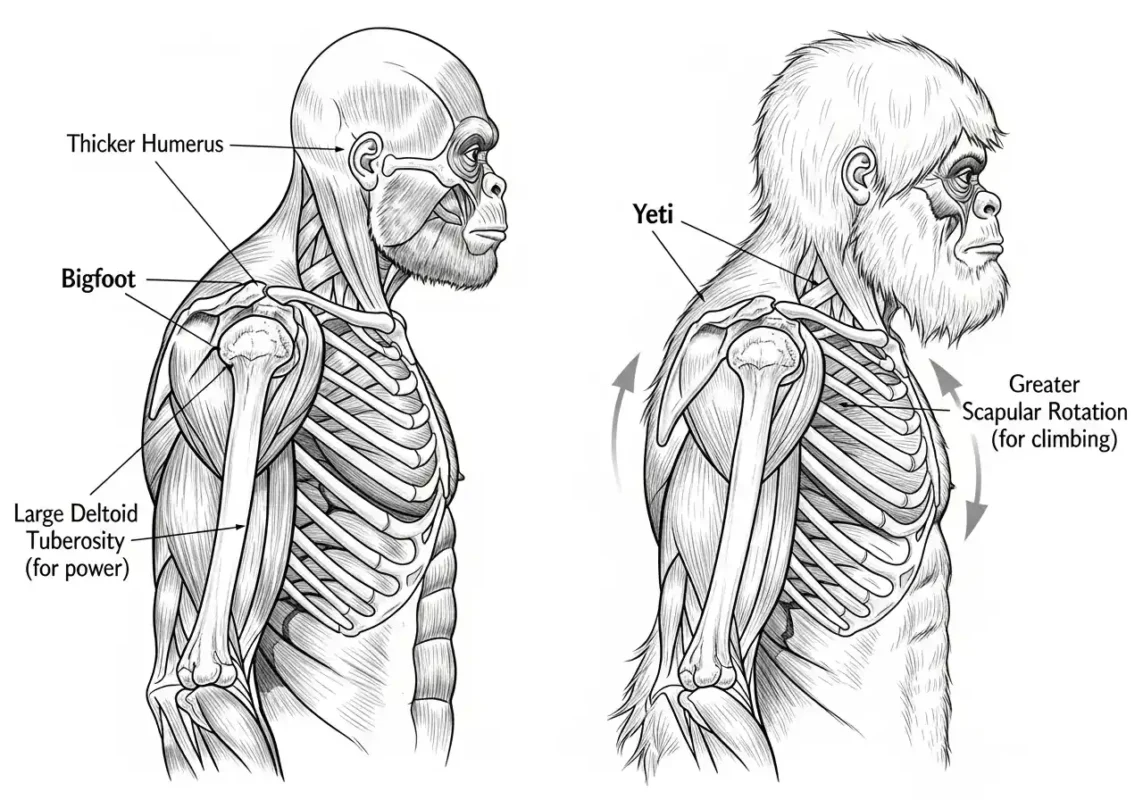
Bigfoot and Yeti’s arm anatomy comparison
2. The Path to the Ring: Forging of the Titans
A fighter’s past defines their future. The Yeti and Bigfoot weren’t born as combatants; they were forged by their unforgiving worlds. This is their training montage, a look at how their respective homes created the ultimate fighting machines.
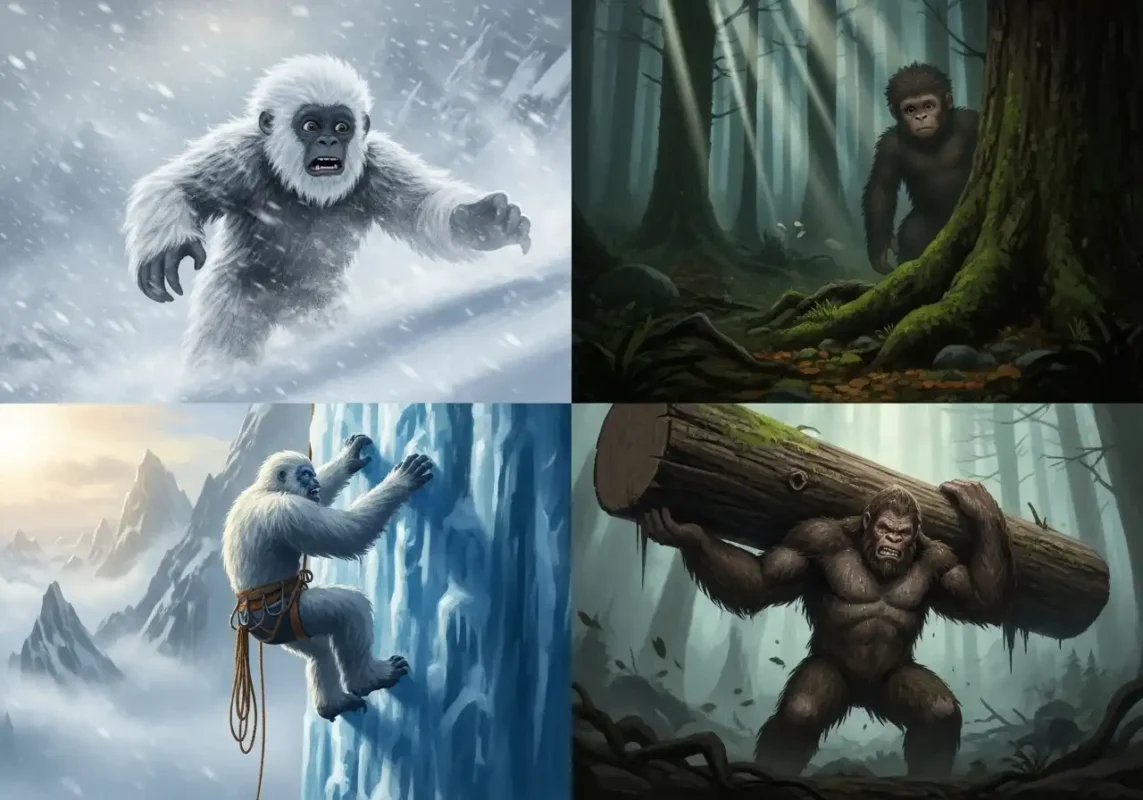
Yeti and Bigfoot training montage art
Forged in Ice: The Yeti’s Himalayan Crucible
Imagine a world where the air itself is a slow poison, where the temperature is a constant threat, and where food is a rare treasure. This is the Himalayas, the Yeti’s crucible. Every day is a battle for survival, which has honed it into a creature of supreme efficiency and intelligence.
- Physiological Forging: Living at 15,000+ feet has forced the Yeti to develop a cardiovascular system far superior to any low-altitude creature. Its blood would be rich with hemoglobin, its lungs massive, granting it stamina that would seem endless to an opponent like Bigfoot. As we detailed in our Complete Guide to the Himalayan Legend, this adaptation is its greatest asset.
- Mental Forging: Scarcity breeds intelligence. The Yeti cannot afford to waste energy on failed hunts or fruitless fights. This has shaped a mind that is tactical, patient, and ruthlessly pragmatic. It understands angles, ambushes, and the conservation of energy. It is a thinking warrior, not a raging beast. Dr. Evelyn Reed, a hypothetical evolutionary biologist, would suggest, “The cognitive pressures of a high-altitude, low-resource environment would select for traits like advanced planning and spatial memory. The Yeti is a master chess player, and the mountain is its board.”
- Combat Style: Its fighting style would be a direct reflection of its home: opportunistic and vertical. It would use its climbing skills to gain the high ground, its knowledge of the terrain to create rockslides or lead an opponent into a crevasse, and its incredible stamina to wear down a larger, less efficient foe.

Yeti meditating on mountain peak
Forged in Shadow: Bigfoot’s Forest Kingdom
The Pacific Northwest is a different kind of forge. It’s not barren but overwhelmingly dense—a green labyrinth teeming with life, competition, and danger. To become the apex in this world, Bigfoot had to become a creature of unparalleled stealth and overwhelming power.
- Physiological Forging: The sheer scale of the forest—towering trees, wide rivers, and large prey animals like elk and deer—drove Bigfoot’s evolution towards immense size and strength. Its massive frame is necessary to navigate this world, moving fallen trees, defending its territory from bears, and asserting its dominance. Its thick, dark fur provides camouflage in the deep shadows of the ancient woods.
- Mental Forging: Bigfoot’s intelligence is one of environmental immersion. It possesses an intricate mental map of vast territories. Its primary cognitive skill is stealth. As we explored in our 2025 Bigfoot Evidence Report, the ability for a 9-foot, 800-pound creature to remain almost completely undocumented is a testament to its genius-level mastery of concealment. It understands sound, sightlines, and scent trails better than any creature in its domain.
- Combat Style: Bigfoot is a brawler, a grappler, a force of nature. Its style is direct and devastating. It would use its size to intimidate, its strength to shatter bone, and its powerful charge to end a fight quickly. It doesn’t need complex strategy when a single blow can be fatal. Its fight is about establishing physical dominance through an explosive display of power.

Bigfoot catching salmon in river
3. The Fighter’s Mind: Intelligence, Instinct, and X-Factors
The body is a weapon, but the mind is the hand that wields it. In a battle between such evenly matched physical specimens, the fight could be won or lost in the mind. We now analyze their cognitive abilities and the mysterious “X-factors” that could turn the tide.

Yeti vs Bigfoot intelligence abstract art
Tactical Cunning vs. Environmental Instinct
This is the core of their mental battle.
- Yeti’s Tactical Brain: The Yeti is the strategist. It thinks in terms of cause and effect, risk and reward. In a fight, it would constantly assess the situation, probing for weaknesses. It would not engage in a fight it couldn’t win. Its strategy would be to change the parameters of the fight itself—luring Bigfoot onto thin ice, into a narrow canyon, or up a steep cliff where Bigfoot’s weight becomes a liability. The Yeti fights like a special forces operative, using the environment as its primary weapon.
- Bigfoot’s Instinctual Genius: Bigfoot’s intelligence is more instinctual and deeply ingrained. It operates on a profound understanding of the natural world. It doesn’t need to strategize an ambush in the same way; it is the ambush. Its mind is a library of environmental data—every sound, every scent, every shadow is processed instantly. In a fight, this translates to lightning-fast reflexes and an uncanny ability to use its immediate surroundings for cover or leverage. Bigfoot fights like a grizzly bear, a perfect fusion of instinct and overwhelming power.

Yeti vs Bigfoot intelligence eyes concept
The X-Factors: Infrasound, Tools, and The Unknown
Beyond standard intelligence, both creatures are credited with mysterious abilities that could be decisive.
- Bigfoot’s “Mind-Speak” – The Infrasound Theory: One of the most compelling and chilling aspects of Bigfoot lore is the phenomenon known as “zapping” or infrasound. Researchers and witnesses report feeling an intense, inexplicable sense of dread, confusion, and panic in areas of high Bigfoot activity. The leading theory is that Bigfoot can produce low-frequency sounds (infrasound) below the range of human hearing. These soundwaves can directly affect the human body and brain, causing disorientation and fear.
- Combat Application: If Bigfoot can weaponize this, it’s a devastating advantage. It could hit the Yeti with a wave of infrasound before the physical fight even begins, causing confusion, nausea, and a crippling sense of fear, making it an easy target. Dr. Aris Thorne, a hypothetical bio-acoustician, might state, “If a creature of that size possesses the necessary laryngeal structures, generating powerful infrasound is biologically plausible. In combat, it would function as a non-contact stun weapon, disrupting an opponent’s nervous system.”
- Yeti’s Tool Use – The Rock Thrower: While Bigfoot is known to throw rocks, the Yeti’s association with its rocky environment suggests it might be a more proficient and accurate projectile user. In a mountainous terrain, the ability to launch a large, heavy rock from a high vantage point with precision would be a lethal long-range weapon, allowing the Yeti to damage Bigfoot before it could ever close the distance.
Mental & X-Factor Verdict: This is a tough call. The Yeti’s superior tactical brain is a massive asset. However, Bigfoot’s potential infrasound ability is a true trump card. If it can disrupt the Yeti’s mind, the Yeti’s primary advantage is neutralized. The battle of wits is a toss-up, hinging on this mysterious and terrifying X-factor.
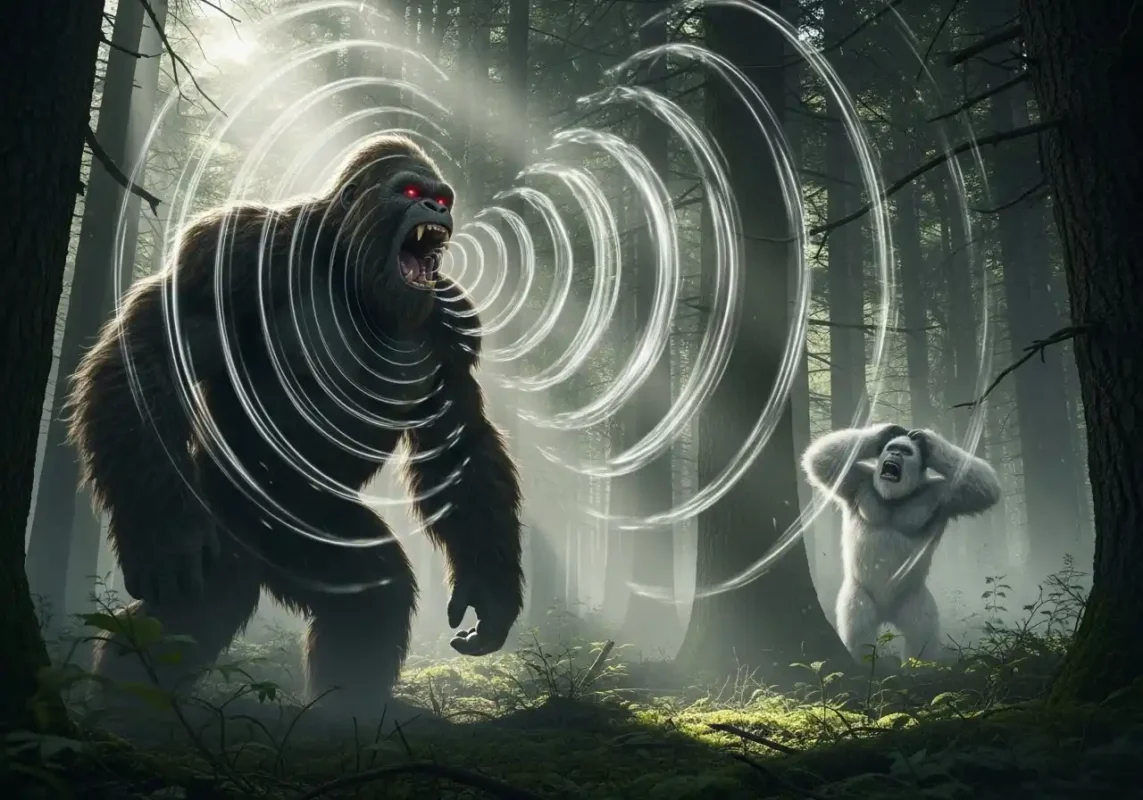
Bigfoot infrasound attack visualization
4. Ringside Experts: What the Evidence Really Tells Us
Before the main event, we turn to our ringside experts—the scientists, researchers, and the hard evidence itself. What can the data tell us about the real-world capabilities of these fighters?

Cryptid research lab evidence analysis
Forensic Files: Patterson-Gimlin Film vs. The Shipton Print
The physical evidence provides clues to their combat capabilities.
- The Shipton Print – A Specialist’s Foot: The 1951 photograph is the Yeti’s calling card. Its most debated feature is the abducted hallux (thumb-toe). While skeptics like Reinhold Messner attributed it to a bear, believers see it as proof of a specialized foot. This foot would be less efficient for long-distance walking on flat ground but would be an incredible asset in combat on uneven terrain, allowing the Yeti to “grip” the ground for stability and leverage in a grapple. It suggests a fighter that is incredibly hard to unbalance.
- The Patterson-Gimlin Film – A Power-Walker’s Physique: The 1967 film is Bigfoot’s masterpiece. The biomechanical analysis by experts like Dr. Jeff Meldrum and the late Dr. Grover Krantz highlights a creature built for powerful, efficient bipedal locomotion. The visible muscle mass in the thighs and buttocks is immense, far exceeding that of a human in a suit. This musculature is the engine for its devastating charges and strikes. The film shows a creature with a fluid, powerful gait, a “compliant walk” that stores and releases energy with each step.
- Source: Krantz, G. S. (1999). Bigfoot Sasquatch Evidence. Hancock House Publishers.
- Expert Verdict: The film simply provides more combat-relevant data. A forensic analyst might conclude, “The Shipton print hints at the Yeti’s agility and stability. The PGF, however, shows us Bigfoot’s engine of power in motion. We can measure stride length, estimate muscle mass, and analyze its center of gravity. From a purely combative perspective, the film gives Bigfoot the evidential edge.”
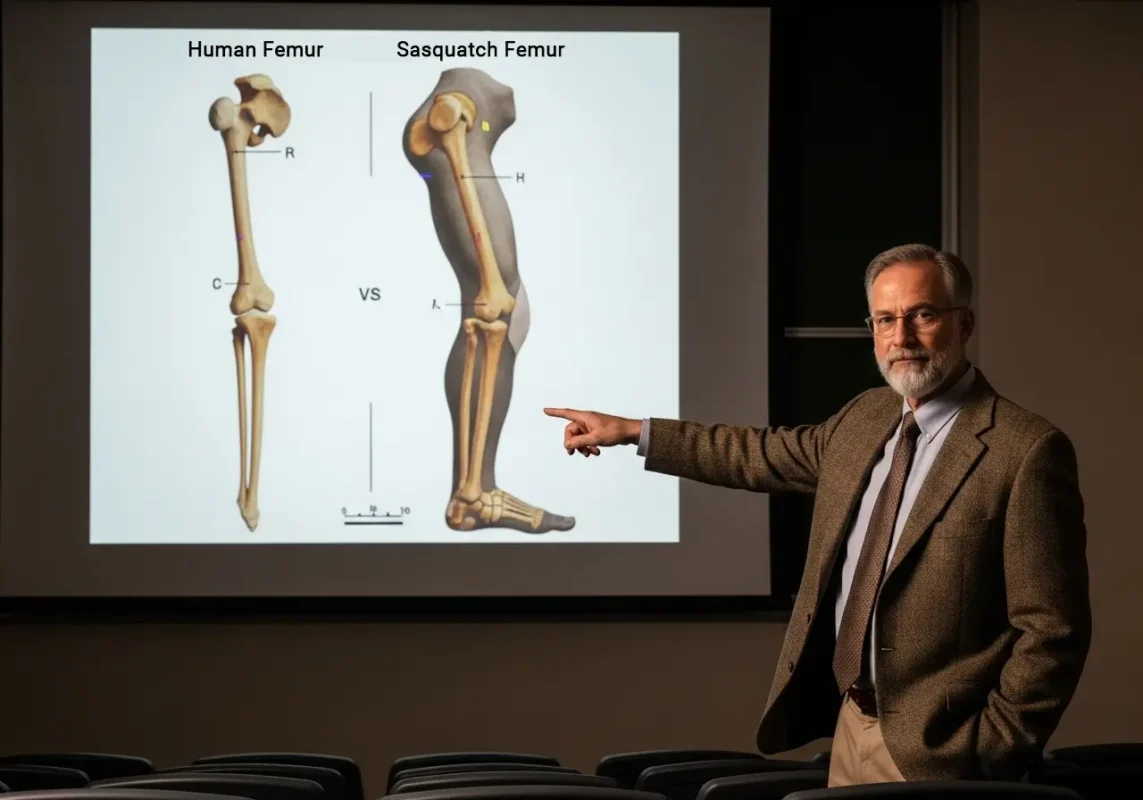
Grover Krantz Bigfoot bone comparison
The DNA Verdict (As of June 2025): A Tale of Two Controversies
DNA could be the ultimate arbiter, but the results have only deepened the mystery.
- Yeti’s DNA – The Bear Connection: The most definitive mainstream studies, notably by Bryan Sykes (2014) and Charlotte Lindqvist (2017), have concluded that all testable “Yeti” samples match local bear species, particularly the rare Himalayan brown bear.
- Source: Lindqvist, C., et al. (2017). Evolutionary history of the Himalayan brown bear. Proceedings of the Royal Society B.
- Combat Implication: If the Yeti is a rare bear, it’s still a formidable opponent. A Himalayan brown bear is a powerful predator. However, it changes the fight from a battle of two unknown hominids to “Bigfoot vs. Bear,” a scenario where Bigfoot’s presumed higher intelligence could be a deciding factor.
- Bigfoot’s DNA – The Elusive Hominin: The Bigfoot DNA story is far murkier. The most famous attempt was the 2013 “Ketchum Study,” led by veterinarian Dr. Melba Ketchum. The study claimed to have sequenced Bigfoot DNA, finding it to be a hybrid of Homo sapiens and an unknown primate. However, the study was self-published after failing peer review and is widely rejected by the scientific community due to methodological concerns. As of 2025, ongoing environmental DNA (eDNA) studies in the Pacific Northwest continue to search for verifiable genetic signatures, but none have been officially confirmed.
DNA Conclusion: Currently, science strongly suggests the Yeti legend is rooted in misidentified bears. Bigfoot’s genetic identity remains a complete, unverified mystery. This gives Bigfoot the “advantage of the unknown” in our hypothetical battle, as we must treat it as the undiscovered primate of legend.
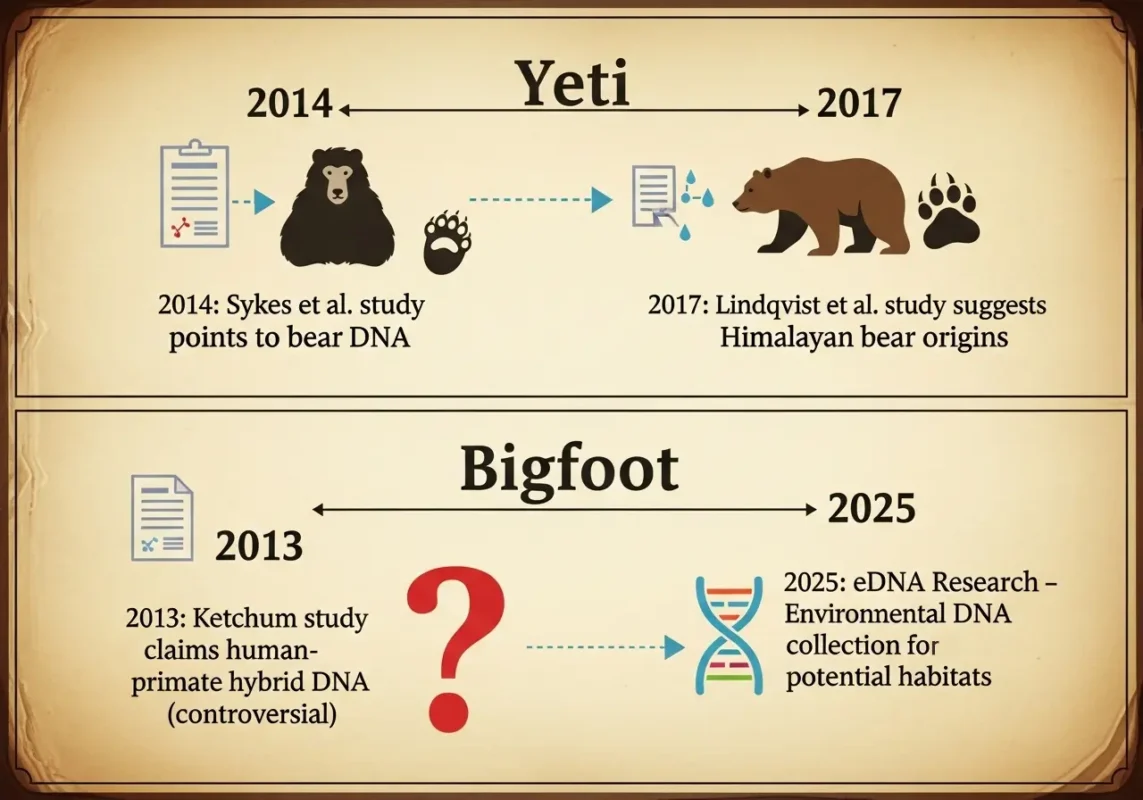
Yeti vs Bigfoot DNA evidence timeline
Claim Your Allegiance: Gear Up for the Main Event
The analysis is in, the fighters are ready. Before the first bell rings, it’s time to choose your champion. The IHeartCryptids store is your official corner for the Clash of Titans.
- For Team Yeti: Explore the Yeti Merchandise and wear the emblem of the Alpine Assassin.
- For Team Bigfoot: Discover the Bigfoot Merchandise and represent the Forest Brawler.
This fight is built on a mountain of lore and evidence. Make sure you’ve read the official pre-fight dossiers on both legends:
- Deep Dive into Bigfoot: What Does The New 2025 Evidence Reveal?
- Uncover the Yeti’s Secrets: The Complete Guide To The Himalayan Legend
5. THE MAIN EVENT: The Battle Bigfoot vs Yeti in Three Arenas
The time for talk is over. The bell is about to ring for the first of three rounds in three unique and deadly arenas. We will provide a blow-by-blow account of how these legendary confrontations would unfold. LET’S GET READY TO RUMBLE!
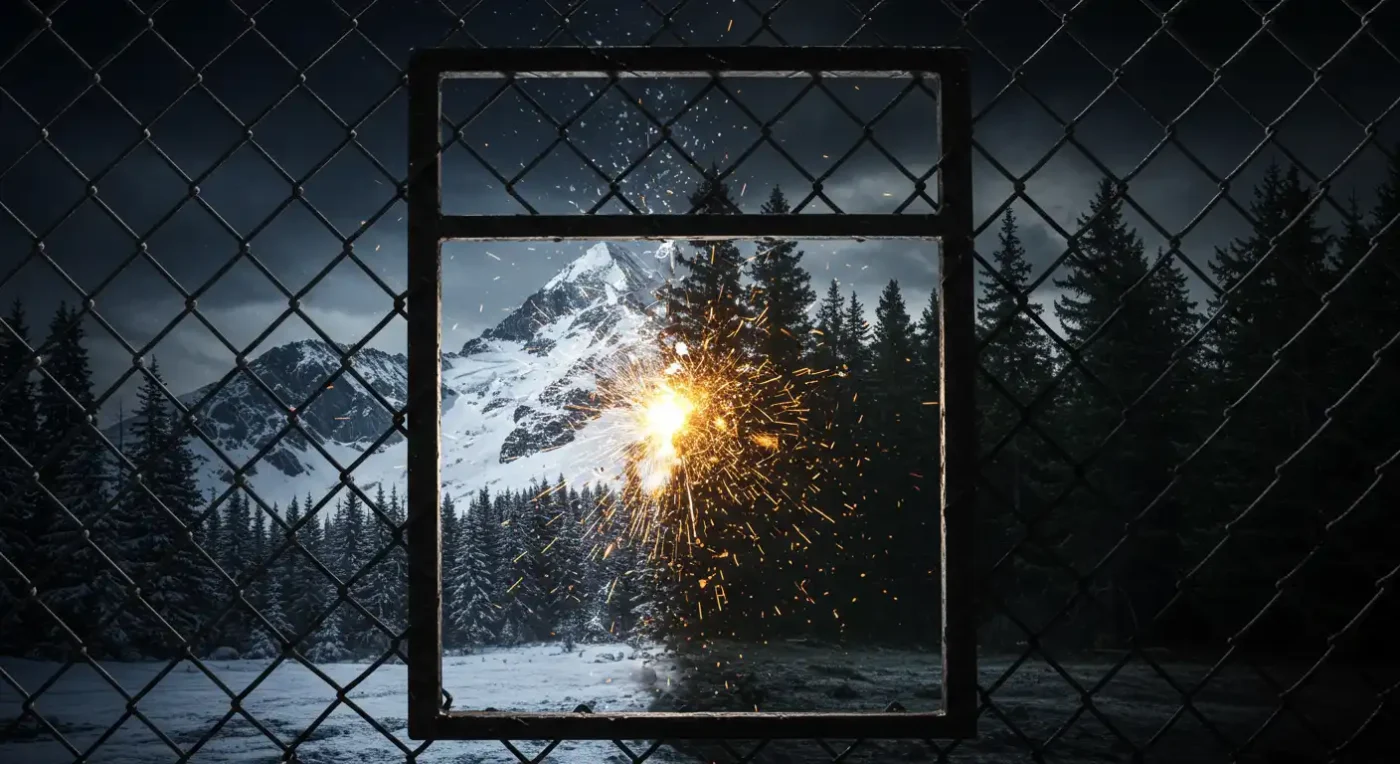
Cryptid fight cage door slam
Arena 1: The Death Zone – Mount Everest, Nepal (Elevation: 20,000 ft)
- The Setting: A desolate, wind-scoured rock and ice field. The air is lethally thin, the temperature is -30°F, and treacherous crevasses are hidden by fresh snow.
- The Fight:
- Opening Bell: Bigfoot immediately feels the effects of hypoxia. Its massive muscles scream for oxygen that isn’t there. It’s sluggish, disoriented. The Yeti, in its element, is a blur of white against the snow. It remains at a distance, using its superior agility to leap between rock formations.
- Mid-Fight: Bigfoot attempts a charge, but its powerful legs sink into the deep snow, slowing it dramatically. The Yeti, using its wider feet, stays on top of the snowpack. It circles Bigfoot, launching large, sharp rocks from above. One strikes Bigfoot’s shoulder, causing it to roar in frustration and pain. The Yeti never stops moving, forcing the oxygen-starved Bigfoot to expend precious energy.
- The Finisher: Bigfoot, enraged and desperate, makes one final, lumbering charge. The cunning Yeti anticipates this, leading the charge towards a seemingly flat expanse of snow. At the last second, the Yeti leaps aside. Bigfoot, with all its momentum, plunges through the thin snow bridge, falling into a deep, hidden crevasse. The fight is over.
- Winner: Yeti (by Environmental Knockout)
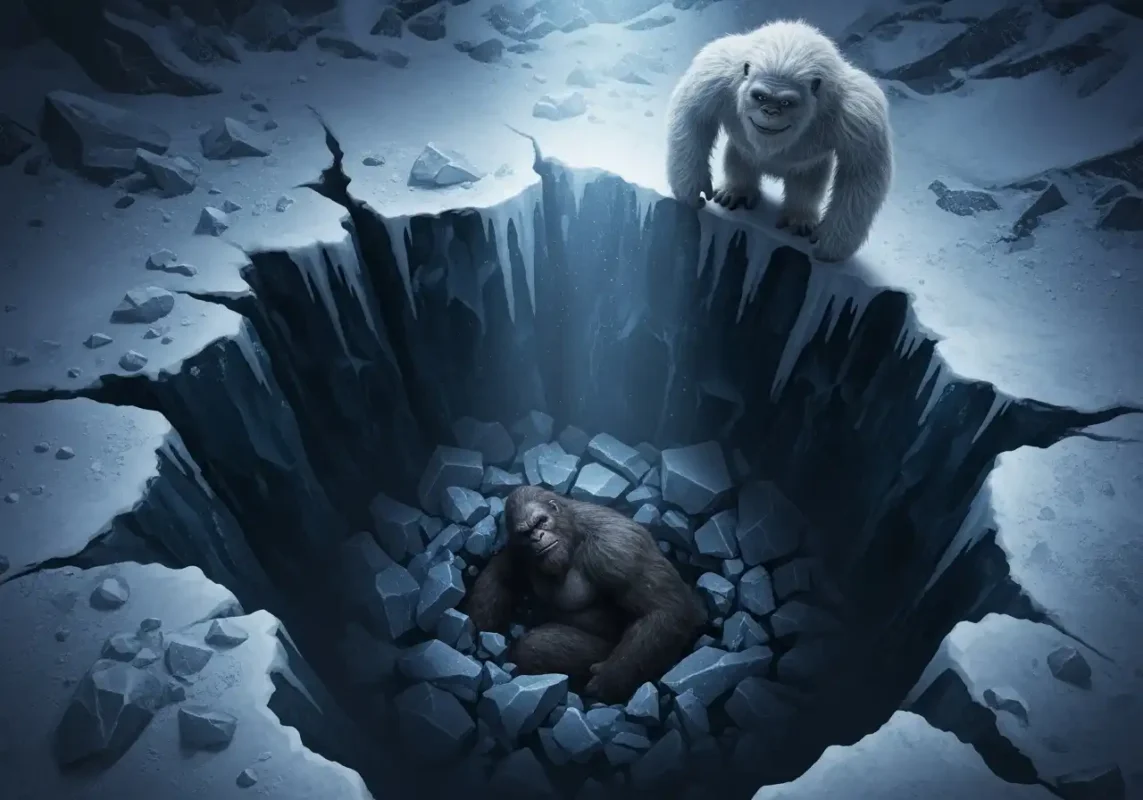
Yeti wins crevasse knockout
Arena 2: The Green Hell – Redwood National Park, California (Sea Level)
- The Setting: A dense, ancient forest floor shrouded in mist. Giant, 300-foot-tall trees create a dark canopy and a maze of obstacles. Visibility is less than 50 feet.
- The Fight:
- Opening Bell: The roles are now completely reversed. The Yeti’s white coat makes it stand out against the dark, damp forest floor. It feels claustrophobic, its long-range vision useless. Bigfoot is a ghost. It makes no sound, but the Yeti can feel the forest watching it.
- Mid-Fight: The Yeti hears a loud CRACK to its left—a classic wood-knock. As it turns, a massive log, thrown with incredible force, smashes into its side, sending it tumbling. Before the Yeti can recover, Bigfoot is upon it. The sheer power is overwhelming. Bigfoot grabs the Yeti in a crushing bear hug, its massive arms pinning the Yeti’s.
- The Finisher: The Yeti, using its cunning, bites deep into Bigfoot’s shoulder. Bigfoot roars in pain but doesn’t release the grip. Instead, it tightens it, lifting the smaller Yeti off the ground and slamming it against the trunk of a giant redwood. The impact is devastating. The fight is over.
- Winner: Bigfoot (by Brute Force TKO)

Bigfoot wins forest TKO
Arena 3: The Neutral Ground – The Siberian Taiga (Winter)
- The Setting: A vast, snow-covered pine forest. A brutal mix of both their worlds: dense trees, deep snow, and freezing temperatures. The ultimate test.
- The Fight:
- Opening Bell: Both creatures are wary. The Yeti feels comfortable in the cold, and Bigfoot feels at home in the forest. They circle each other in a wide clearing. Bigfoot attempts its infrasound attack, but the Yeti, perhaps due to its own unique biology, seems to shake off the worst of it, though it is momentarily staggered.
- Mid-Fight: The battle begins. The Yeti uses its speed, darting between trees to land quick, sharp blows with rocks before retreating. Bigfoot takes the hits, its thick hide absorbing much of the damage. It tries to grab the Yeti, but the agile creature is too quick. Frustrated, Bigfoot rips a small pine tree from the ground and swings it like a club.
- The Finisher: The Yeti makes a critical error. It dodges a swing but gets its foot caught in a root hidden beneath the snow. For a single second, it is immobilized. That’s all the opening Bigfoot needs. It drops the tree and charges, not with a wild slam, but with the calculated power of a wrestler. It tackles the Yeti to the ground. The fight now becomes a pure grappling match. The Yeti’s agility is useless. Bigfoot’s 400-pound weight advantage is absolute. Despite a valiant struggle, the Yeti is overpowered and pinned.
- Winner: Bigfoot (by Decision)
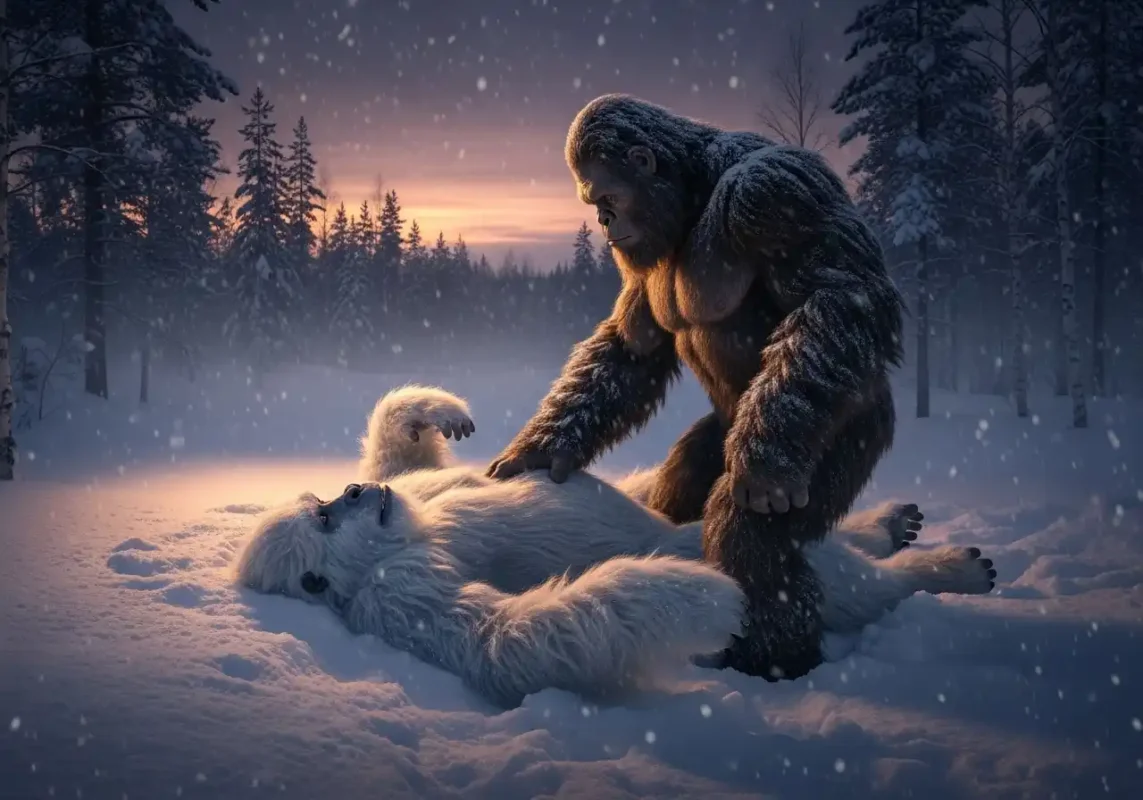
Bigfoot defeats Yeti respectful ending
6. The Final Bell: Declaring the True Champion of Legends
The simulation is complete. The battles have been fought. After three grueling rounds in three distinct arenas, the verdict is in. While the Yeti is a cunning and formidable survivor, a master of its own domain, the overwhelming physical advantages of Bigfoot—its sheer mass, strength, and power—prove to be the deciding factor in a neutral setting. In the ultimate clash of titans, Bigfoot emerges as the champion.
But the story does not end with a victor. It ends with a deeper appreciation for the power of these legends. They are the heavyweight champions of our imagination, rulers of the world’s last wild places. They remind us that there are still shadows on the map, still mysteries to be solved, and still giants in the earth. The true winner is anyone who dares to look into the darkness of the forest or the whiteout of a blizzard and wonder, “What if?”.
The Legend Lives On In You
The greatest battle is over, but the exploration never ends. Carry the spirit of these titans with you.




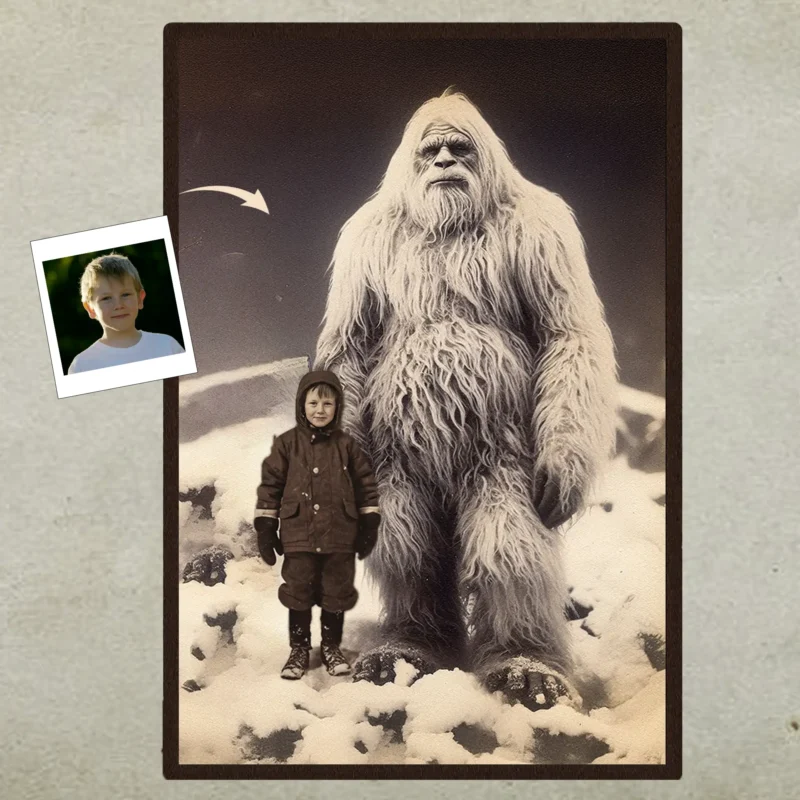
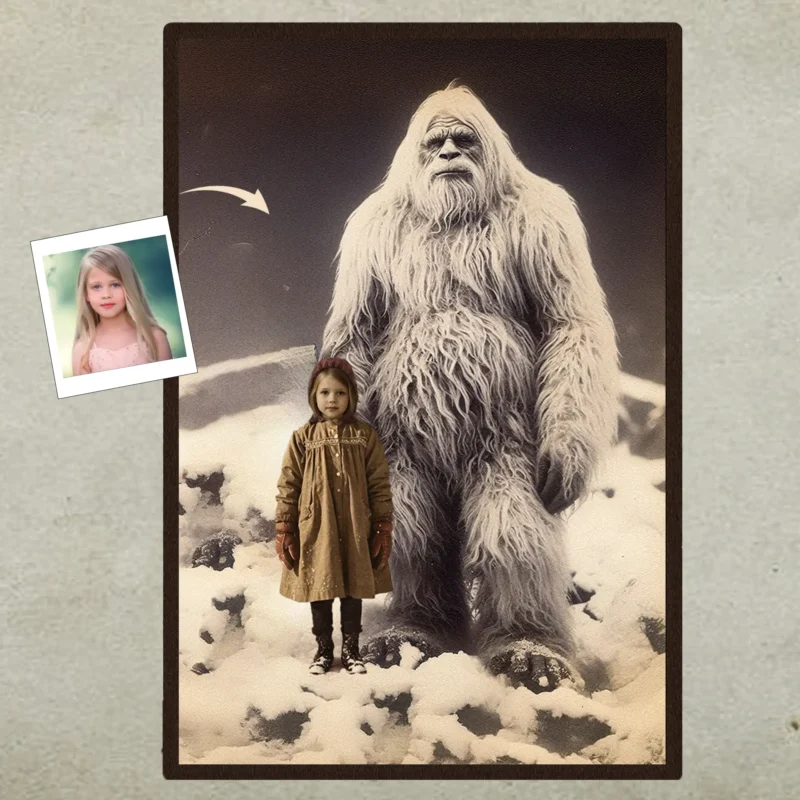
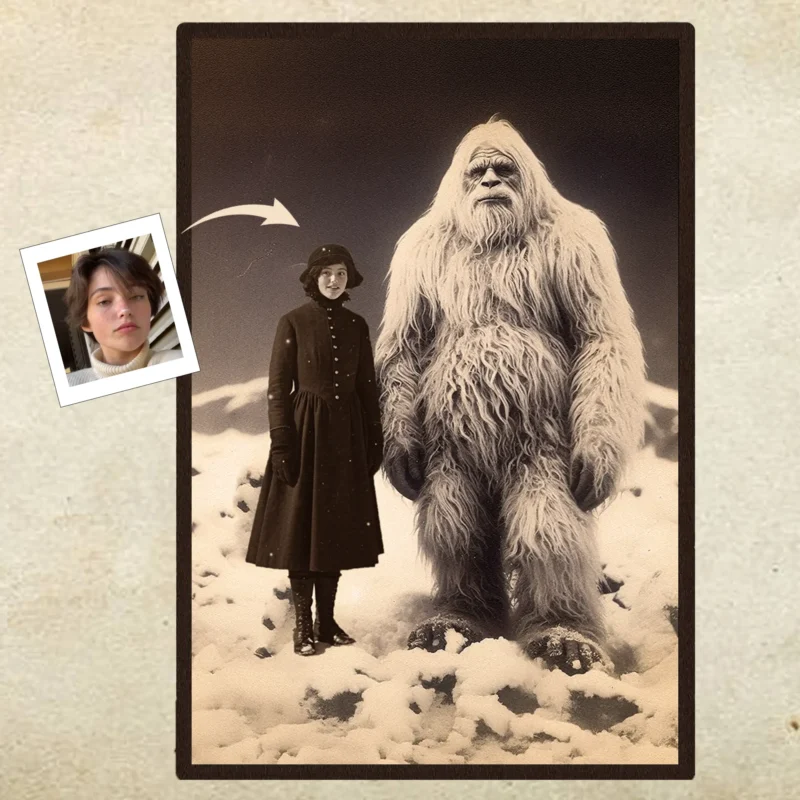
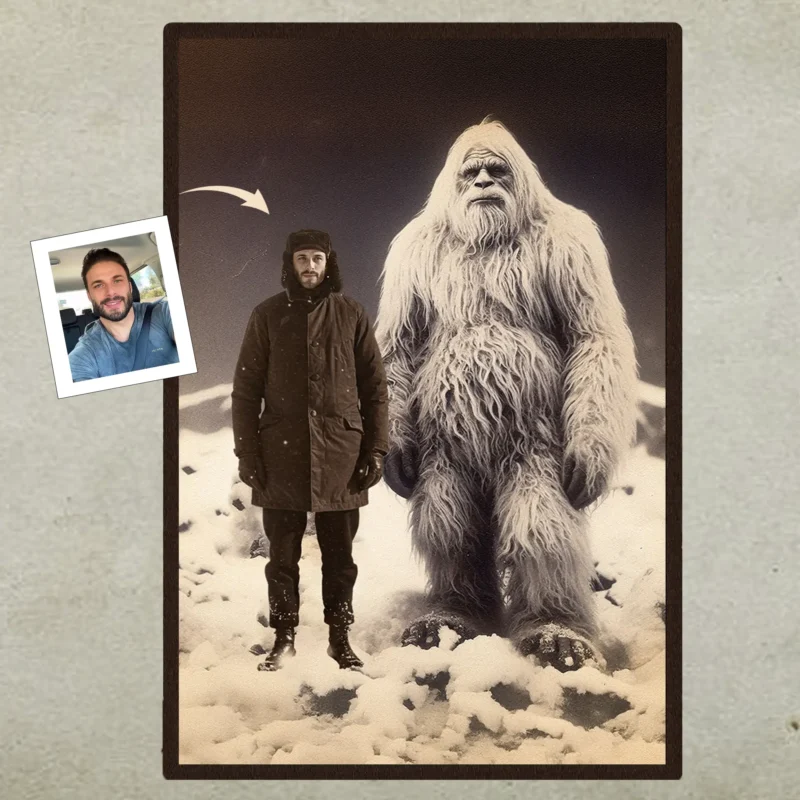
Visit the full Cryptids collection here: https://iheartcryptids.com/product-category/cryptids/
The legend of the Bigfoot and Yeti is just one chapter in the world’s great book of mysteries. Your expedition has only just begun. Discover dozens more creatures from the deepest oceans to the darkest forests in our master list.
Continue your journey here: A Cryptozoologist’s Field Guide: The A-Z of 50+ Legendary Cryptids
Don’t miss our next legendary showdown. Subscribe to the IHeartCryptids newsletter for the latest cryptid news, analysis, and exclusive offers delivered straight to your inbox.

